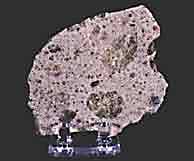Diogenite
Diogenites are a group of the HED meteorite clan, a type of achondritic stony meteorites.
| Diogenite | |
|---|---|
| — Group — | |
 The Johnstown Diogenite. | |
| Type | Achondrite |
| Structural classification | Igneous rocks of plutonic origin |
| Class | Asteroidal achondrite |
| Clan | HED |
| Parent body | 4 Vesta |
| Composition | Primarily magnesium-rich orthopyroxene, a little plagioclase & olivine |
| Total known specimens | ~40 |
 Tatahouine, diogenite | |
Origin and composition
Diogenites are currently believed to originate from deep within the crust of the asteroid 4 Vesta, and as such are part of the HED meteorite clan. There are about 40 distinct members known.
Diogenites are composed of igneous rocks of plutonic origin, having solidified slowly enough deep within Vesta's crust to form crystals which are larger than in the eucrites. These crystals are primarily magnesium-rich orthopyroxene, with small amounts of plagioclase and olivine.[1]
Name
Diogenites are named for Diogenes of Apollonia, an ancient Greek philosopher who was the first to suggest an outer space origin for meteorites.[2]
See also
References
- Beck, A. W.; McSween, H. Y. (2010). "Diogenites as polymict breccias composed of orthopyroxenite and harzburgite". Meteoritics and Planetary Science. 45 (5): 850–872. Bibcode:2010M&PS...45..850B. doi:10.1111/j.1945-5100.2010.01061.x.
- Dawn, Walter & Audrey. "Why is it called Diogenite?". Retrieved 18 July 2011.
External links
- Diogenite images - Meteorites Australia
This article is issued from Wikipedia. The text is licensed under Creative Commons - Attribution - Sharealike. Additional terms may apply for the media files.